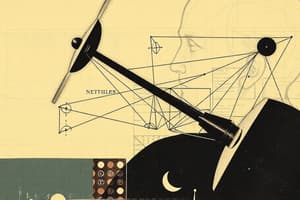Podcast
Questions and Answers
What is the first law of motion also known as?
What is the first law of motion also known as?
inertia
According to the first law of motion, what happens to an object in motion if no external force acts on it?
According to the first law of motion, what happens to an object in motion if no external force acts on it?
It tends to stay in motion
What is the equation that represents the relationship between force, mass, and acceleration in the second law of motion?
What is the equation that represents the relationship between force, mass, and acceleration in the second law of motion?
F = ma
What does the third law of motion state about forces between two bodies?
What does the third law of motion state about forces between two bodies?
How does an object at rest behave according to the first law of motion?
How does an object at rest behave according to the first law of motion?
What is the principle that objects resist changes in their state of motion or rest?
What is the principle that objects resist changes in their state of motion or rest?
Define work in physics.
Define work in physics.
Give an example where work is being done.
Give an example where work is being done.
Explain the concept of energy in physics.
Explain the concept of energy in physics.
What is kinetic energy dependent on?
What is kinetic energy dependent on?
When does gravitational potential energy come into play?
When does gravitational potential energy come into play?
How is total mechanical energy calculated?
How is total mechanical energy calculated?
What is power and how is it calculated?
What is power and how is it calculated?
How does a high-powered engine enable faster accelerations in race cars?
How does a high-powered engine enable faster accelerations in race cars?
Name two practical applications where understanding power is crucial.
Name two practical applications where understanding power is crucial.
Explain the significance of power in the context of human progress.
Explain the significance of power in the context of human progress.
How does power contribute to our comprehension of simple machines?
How does power contribute to our comprehension of simple machines?
Flashcards are hidden until you start studying
Study Notes
Laws of Motion in Physics
At the core of classical mechanics lies our understanding of laws of motion, which govern how objects interact and behave. Let's dive deep into these fundamental principles outlined by Sir Isaac Newton, laying the foundation for modern physics and technological advancements alike.
First Law of Motion
Known as the principle of inertia, it states that an object in motion tends to stay in motion unless acted upon by an external force, and likewise, an object at rest remains at rest. In essence, objects resist changes in their state of motion or rest.
Second Law of Motion
This law describes the relationship between forces acting on an object, mass, and acceleration, establishing the equation (F = ma), wherein (F) represents net force, (m) denotes mass, and (a) signifies acceleration. In simpler terms, an increase in force will cause an increase in mass's acceleration, assuming no change in direction occurs.
Third Law of Motion
Also known as action–reaction law, this dictum declares that whenever one body applies a force on another, the second body simultaneously exerts a force equal in magnitude and opposite in direction on the first body. In short, for every interaction, there exists both a mutual cause and effect.
These laws form the bedrock of classical mechanics, allowing us to comprehend everything from the flight of a ball to the functioning of spacecraft. Though these theories cannot explain all phenomena, their validity extends far wider than initially anticipated, providing a reliable framework for studying a diverse array of natural processes and manmade machinery.
Studying That Suits You
Use AI to generate personalized quizzes and flashcards to suit your learning preferences.




